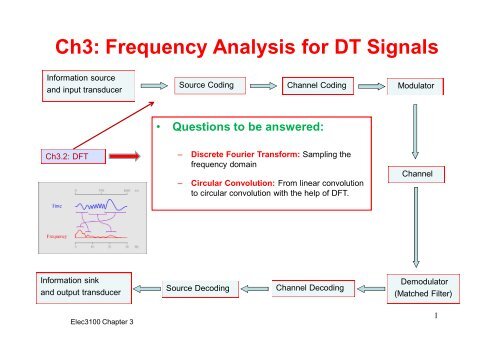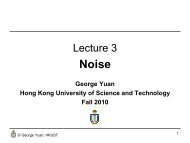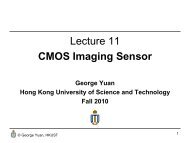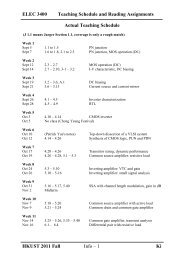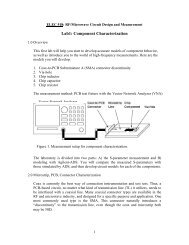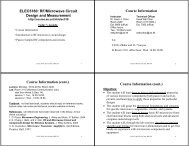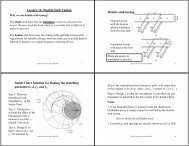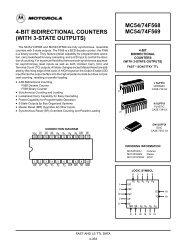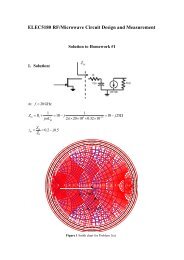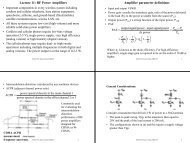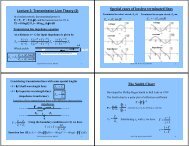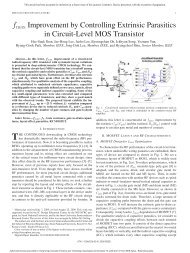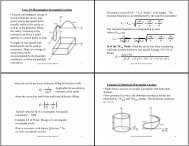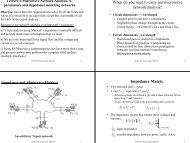Ch3.2 Discrete Fourier Transform
Ch3.2 Discrete Fourier Transform
Ch3.2 Discrete Fourier Transform
You also want an ePaper? Increase the reach of your titles
YUMPU automatically turns print PDFs into web optimized ePapers that Google loves.
Ch3: Frequency Analysis for DT Signals<br />
Information source<br />
and input transducer<br />
Source Coding<br />
Channel Coding<br />
Modulator<br />
• Questions to be answered:<br />
<strong>Ch3.2</strong>: DFT<br />
– <strong>Discrete</strong> <strong>Fourier</strong> <strong>Transform</strong>: Sampling the<br />
frequency domain<br />
– Circular Convolution: From linear convolution<br />
to circular convolution with the help of DFT.<br />
Channel<br />
Information sink<br />
and output transducer<br />
Source Decoding<br />
Channel Decoding<br />
Demodulator<br />
(Matched Filter)<br />
Elec3100 Chapter 3<br />
1
<strong>Ch3.2</strong>: <strong>Discrete</strong> <strong>Fourier</strong> <strong>Transform</strong><br />
• <strong>Discrete</strong> <strong>Fourier</strong> <strong>Transform</strong><br />
• Circular Convolution<br />
Elec3100 Chapter 3<br />
2
WiFi and OFDM<br />
Elec3100 Chapter 3<br />
3
<strong>Discrete</strong> Time <strong>Fourier</strong> <strong>Transform</strong> (DTFT)<br />
• With DTFT, we have limited number of samples in time domain,<br />
but continuous function in the frequency domain.<br />
• As a result, DTFT is not directly applicable to the digital analysis.<br />
(Why?)<br />
• Questions:<br />
– Can we reconstruct the time-domain samples by part of the frequency<br />
domain signals? (Periodic?)<br />
– Can we utilize limited number of samples from the frequency-domain<br />
to reconstruct the time-domain samples? (Sampling Frequency-<br />
Domain?)<br />
Elec3100 Chapter 3<br />
4
<strong>Discrete</strong> <strong>Fourier</strong> <strong>Transform</strong> (DFT)<br />
• The simplest relation between a length-N sequence and its<br />
DTFT is obtained by uniformly sampling on the -<br />
axis at <br />
,01.<br />
<br />
• From the definition of DTFT, we have<br />
|<br />
<br />
<br />
<br />
<br />
<br />
• Note: is also a length-N sequence in the frequency domain.<br />
Elec3100 Chapter 3<br />
5
Inverse <strong>Discrete</strong> <strong>Fourier</strong> <strong>Transform</strong> (IDFT)<br />
• The sequence is called the discrete <strong>Fourier</strong> transform<br />
(DFT) of sequence .<br />
• Utilizing the notation , DFT is usually expressed as<br />
<br />
<br />
<br />
<br />
,01<br />
• The inverse discrete <strong>Fourier</strong> transform (IDFT) is given by<br />
<br />
1 <br />
<br />
,01<br />
• Question: Can we uniquely reconstruct from ? In other words,<br />
is ?<br />
Elec3100 Chapter 3<br />
6
Inverse <strong>Discrete</strong> <strong>Fourier</strong> <strong>Transform</strong> (IDFT)<br />
• From the definition of the inverse discrete <strong>Fourier</strong> transform<br />
(IDFT), ∑ <br />
.<br />
<br />
• By substituting ∑<br />
<br />
, we can obtain<br />
∑ <br />
∑<br />
<br />
<br />
• Given ∑<br />
<br />
<br />
we have .<br />
<br />
<br />
<br />
<br />
∑ ∑ <br />
<br />
<br />
∑ ∑ <br />
<br />
<br />
, for , an integer<br />
<br />
0, otherwise ,<br />
• Thus, we can reconstruct from .<br />
Elec3100 Chapter 3<br />
7
<strong>Discrete</strong> <strong>Fourier</strong> <strong>Transform</strong><br />
• Example: Consider the length-N sequence<br />
1, 0<br />
<br />
0, 1 1<br />
• Its N-point DFT is given by<br />
<br />
<br />
<br />
<br />
1,01<br />
0 <br />
<br />
• Example: Consider the length-N sequence<br />
1, , 0 1<br />
<br />
0, otherwise<br />
• Its N-point DFT is given by<br />
∑<br />
<br />
<br />
<br />
<br />
,0 1<br />
Elec3100 Chapter 3<br />
8
<strong>Discrete</strong> <strong>Fourier</strong> <strong>Transform</strong><br />
• Example: Determine DFT of the length-N sequence<br />
cos <br />
,01<br />
<br />
• Using the trigonometric identity, we can obtain<br />
/ / = <br />
<br />
• The N-point DFT is given by<br />
∑<br />
<br />
∑ <br />
<br />
<br />
∑<br />
<br />
<br />
• Using the identity, ∑<br />
<br />
<br />
we get <br />
<br />
<br />
<br />
<br />
,for <br />
,for <br />
0, otherwise<br />
, for , an integer<br />
<br />
0, otherwise<br />
Elec3100 Chapter 3<br />
9
• The DFT samples defined by<br />
Matrix Relations<br />
<br />
<br />
,0 1<br />
<br />
can be expressed in matrix form as where<br />
0 1 … 1 , 0 1 …1 <br />
and<br />
is the DFT matrix given by<br />
Elec3100 Chapter 3<br />
10
Matrix Relations<br />
• The IDFT relation can be expressed as<br />
<br />
where is the IDFT matrix with ∗ where<br />
Elec3100 Chapter 3<br />
11
DFT Properties: Symmetry Relations<br />
Elec3100 Lecture 3 12
General Properties of DFT<br />
Elec3100 Chapter 3<br />
13
Physical Interpretation<br />
• Decomposition of a finite-length signal into a set<br />
of N sinusoidal components<br />
– Take an array of N complex sinusoidal generators;<br />
– Set the frequency of the k-th generator to 2/;<br />
– Set the amplitude of the k-th generator to , i.e. to the<br />
magnitude of the k-th DFT coefficient;<br />
– Set the phase of the k-th generator to ∡ , i.e. to the phase<br />
of the k-th DFT coefficient;<br />
– Start the generators at the same time and sum their outputs.<br />
• The first N output values of this “machine” are exactly x[n].<br />
Elec3100 Chapter 3<br />
14
Physical Interpretation: Example<br />
cos 0, … , 63<br />
8<br />
Elec3100 Chapter 3<br />
15
Physical Interpretation: Example<br />
cos 8 3<br />
0, … , 63<br />
Elec3100 Chapter 3<br />
16
Physical Interpretation: Example<br />
cos 0, … , 63<br />
5<br />
Elec3100 Chapter 3<br />
17
<strong>Ch3.2</strong>: Frequency Analysis for DT Signals<br />
• <strong>Discrete</strong> <strong>Fourier</strong> <strong>Transform</strong><br />
• Circular Convolution<br />
Elec3100 Chapter 3<br />
18
Circular Shift of a Sequence<br />
• Consider a length-N sequence defined for 01.<br />
Sample values are equal to zero for values of 0and .<br />
• For any arbitrary integer , the shifted sequence <br />
, is no longer defined for the range 0 1.<br />
• Thus, we need to define another type of “shift” that will always keep<br />
the shifted sequence in the range 0 1.<br />
• The desired shift, called the circular shift, is defined using a<br />
modulo operation:<br />
<br />
For 0(right circular shift), the above<br />
equation implies<br />
,for 1<br />
,for 0 <br />
Elec3100 Chapter 3<br />
19
Circular Shift of a Sequence<br />
• A right circular shift by is equivalent to a left circular shift by<br />
sample periods.<br />
• A circular shift by an integer number greater than N is equivalent<br />
to a circular shift .<br />
Elec3100 Chapter 3<br />
20
Circular Convolution<br />
• Circular convolution is analogous to linear convolution, but with a<br />
subtle difference.<br />
• Consider two length-N sequences, and , respectively.<br />
• Their linear convolution results in a length 2 1 sequence <br />
given by<br />
<br />
,0 22<br />
<br />
• The longer form results from the time-reversal of the sequence <br />
and its linear shift to the right<br />
Elec3100 Chapter 3<br />
21
Circular Convolution<br />
• To develop a convolution-like operation resulting in a length-N<br />
sequence , we need to define a circular time-reversal, and then<br />
apply a circular time-shift.<br />
• Resulting operation, called a circular convolution, is defined by<br />
∑<br />
,01<br />
<br />
• Since the operation defined involves two length-N sequences, it is<br />
often referred to as an N-point circular convolution, denoted as<br />
N .<br />
• The circular convolution is commutative,<br />
<br />
N<br />
N<br />
Elec3100 Chapter 3<br />
22
Circular Convolution<br />
• Example – Determine the 4-point circular convolution of two length-<br />
4 sequences: 1 2 0 1 and 2 2 1 1 as sketched<br />
below<br />
• The result is a length-4 sequence<br />
∑<br />
N<br />
,03<br />
• For example,<br />
0 ∑<br />
<br />
g0h0 g 1h3 g 2h2 g 3h1<br />
6<br />
Elec3100 Chapter 3<br />
23
Circular Convolution: DFT Method<br />
• Example – Determine the 4-point circular convolution of two length-<br />
4 sequences: 1 2 0 1 and 2 2 1 1 as sketched<br />
below<br />
• The 4-point DFT and are given by<br />
4, 1 , 2, 1 and 6, 1 , 0, 1 .<br />
• Thus, the 4-point DFT of is given by<br />
24, 2, 0, 2.<br />
• A 4-point IDFT of yields<br />
6 7 6 5 .<br />
Elec3100 Chapter 3<br />
24
Circular Convolution<br />
• Example – Now let us extend the two length-4 sequences to<br />
length-7 by appending each with three zero-valued samples<br />
• We next determine the 7-point circular convolution and :<br />
∑<br />
2, 6,5, 5, 4,1,1<br />
• It can be checked that is precisely the sequence <br />
obtained by a linear convolution of <br />
Elec3100 Chapter 3<br />
25
Circular Convolution<br />
Elec3100 Chapter 3<br />
26
Circular Convolution<br />
Elec3100 Chapter 3<br />
27
Circular Convolution<br />
Elec3100 Chapter 3<br />
28
Circular Convolution<br />
Elec3100 Chapter 3<br />
29
Linear Convolution Using the DFT<br />
• Linear convolution is a key operation in many signal processing<br />
applications.<br />
• Since a DFT can be efficiently implemented using FFT algorithms,<br />
it is of interest to develop methods for the implementation of linear<br />
convolution using the DFT.<br />
• Let and be two finite-length sequences of length N and M,<br />
respectively. Denote L=N+M-1. Define two length-L sequences<br />
Elec3100 Chapter 3<br />
30
Linear Convolution Using the DFT<br />
Elec3100 Chapter 3<br />
31


